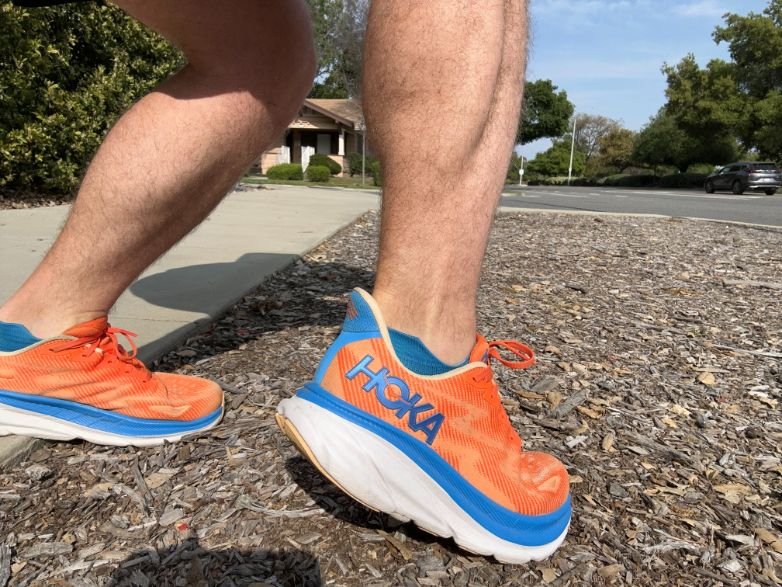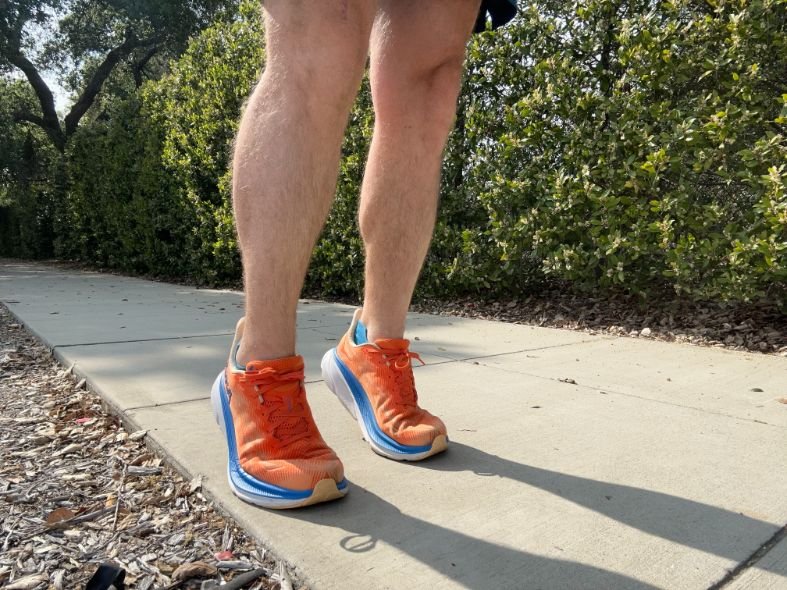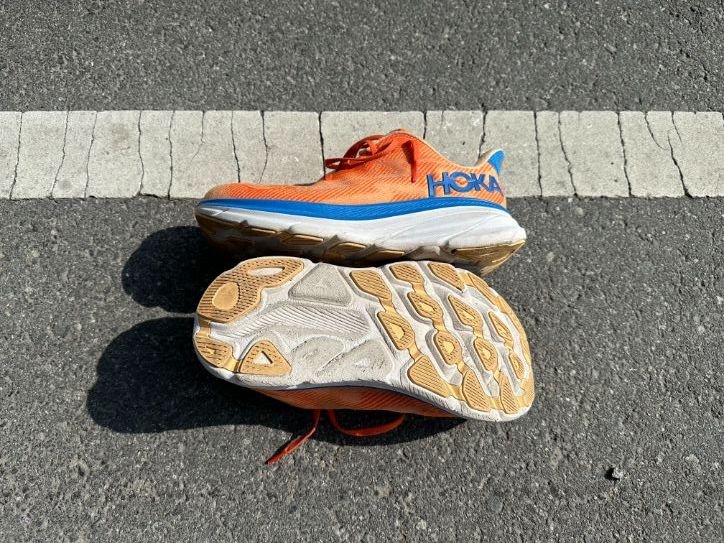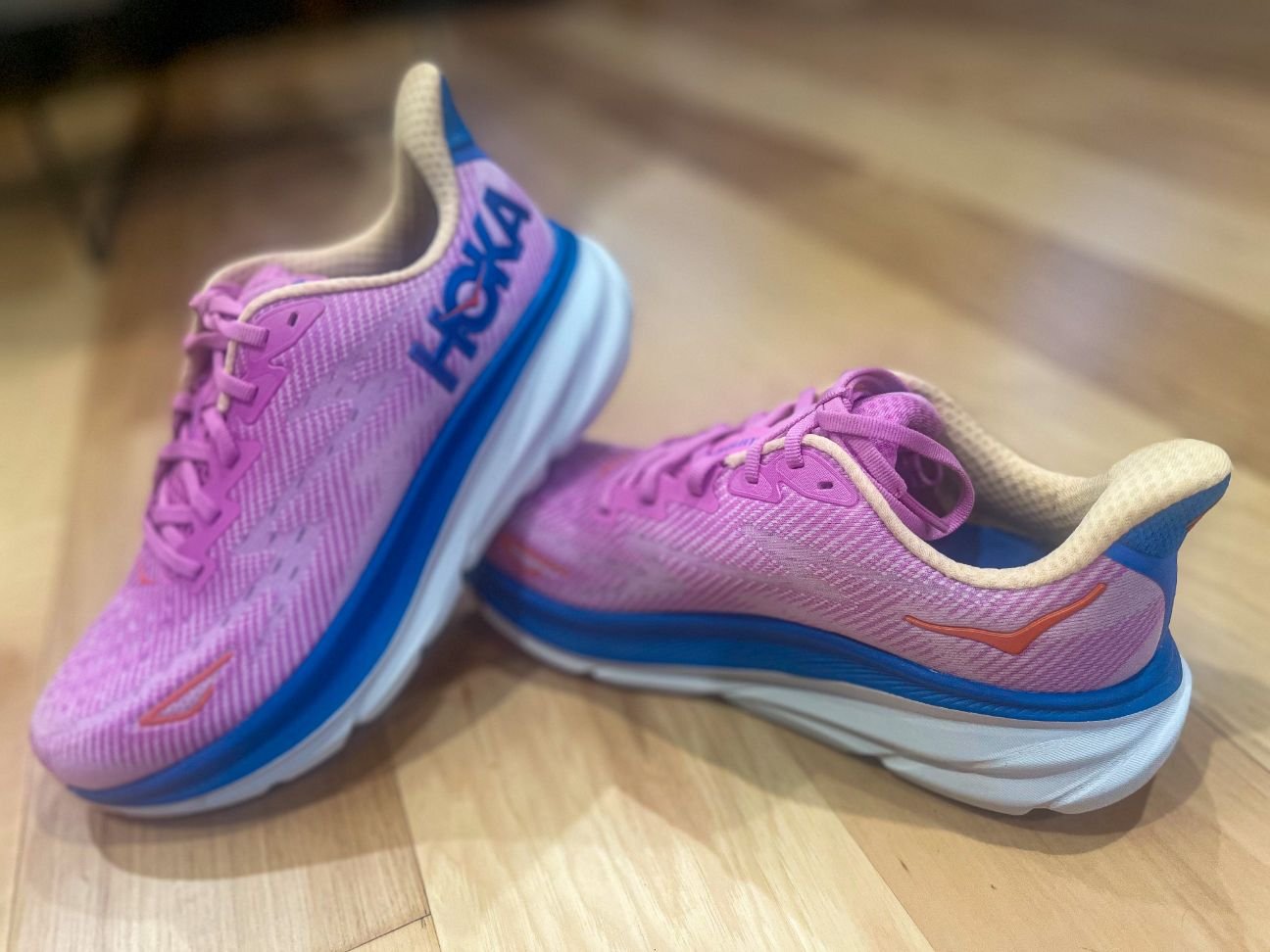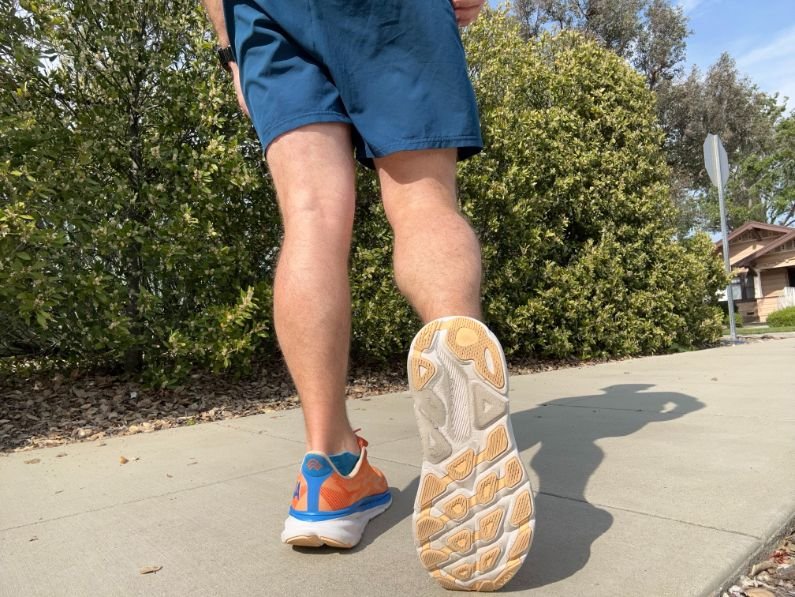HOKA Clifton 9 Running Shoes Review
An in-depth review of the Hoka Clifton 9 shoe for running, walking, and active recovery
The HOKA Clifton shouldn’t take long for most people to break in because it is a neutral shoe with balanced cushion.
February 16th, 2024
Home > Gear Reviews > Footwear
OUR VERDICT
Shortly after testing the HOKA Clifton 8s, we tested the HOKA Clifton 9 running shoes to find out what has changed. After hundreds of miles and hours in these recently-released shoes, our running coaches-turned testers are ready to share their findings in this HOKA Clifton 9 review. For folks looking for shoes to wear on avid walks, training runs, or active recovery days, the HOKA Clifton 9’s lightweight, cushioned, and comfortable fit may be just the ticket.
The shoe’s neutral support, more responsive cushioning, low weight, and Meta-Rocker technology come together to provide a smooth ride ideal for everyday training or active recovery days. With minimal updates to fine-tune the fit, the Clifton 9s are still designed for avid walkers, joggers, or runners training for races and seeking a quality active recovery shoe.
The maximalist cushioning is also helpful for heavier runners, as the plush midsole helps reduce impact with each stride. Like other HOKA shoes, we think that extra cushioning translates to comfort for long hours on your feet (like restaurant workers, medical workers, and folks who work in retail) but are still stylish enough for wearing around town as sneakers.
Editor’s note: The HOKA Clifton 10 is the newest version, although you can still find the Clifton 9, often at a discount. You can read our review of the HOKA Clifton 10 here.
MEN'S
WOMEN'S
We tested a women’s standard fit and a men’s wide so we could see how they stacked up for various foot types. We tested on short easy runs, longer runs up to 20 miles, many a recovery run, and on longer walks.
For this shoe review, we tested the Clifton 8 and Clifton 9s side-by-side. When I tried the 8 on my left foot and the 9 on my right foot, I first noticed the roomier toe box in the 9s. While I didn’t like that extra room, this is good news for folks with longer toes. I also noticed that the upper mesh of the 9s—while still made of vegan materials—feels a little thinner than the 8s, creating a slightly less snug feel. The 9s are also a little more responsive than the 8s in that the midsole is a little more firm and reactive to give runners a little more pep in their step.
The updates are minimal, so unless you’re wearing them side-by-side like me, have been a devoted Clifton wearer for years, or have shorter toes like me, you likely won’t notice significant differences from the 8s to the 9s. In this HOKA Clifton 9 review, we explore the differences between each HOKA running shoe so you can choose the best style and size for you. To compare an even wider range of road running shoes, you can check out the Best Women’s Road Running Shoes review.
Curious about the HOKA Clifton 8? See our in-depth review.
This story may contain affiliate links, which help fund our website. When you click on the links to purchase gear, we may get a commission without costing you an extra cent. This allows us to create reader-supported objective gear reviews. Thank you for supporting our work and mission of outdoor coverage for every body! Learn more.
SPECS
Cushion: maximum cushion
Heel-to-Toe Drop (mm): 5 mm
Stability: neutral
Upper: vegan mesh
Midsole: compression molded EVA
Outsole: rubber
Weight (pair): 1 lb 1.4 oz (men’s), 14.6 oz (women’s)
HOKA CLIFTON 9 VS. SIMILAR MODELS
| ROAD RUNNING SHOE | MAJOR DIFFERENCES FROM CLIFTON 9 |
|---|---|
| HOKA Clifton 9 Men's Women's |
N/A |
| HOKA Clifton 8 Men's Women's |
Lower stack, thicker tongue rubs more, less solid outsole |
| On Cloudsurfer 2 Men's Women's |
Similar cushion, higher heel-to-toe drop |
| New Balance Fresh Foam X 860v14 Men's Women's |
Higher heel-to-toe drop (8mm) |
| Saucony Ride 18 Men's Women's |
Weighs 1.4 oz (per pair) more, higher heel-to-toe drop (8mm) |
WHAT WE LIKED
Maintains ample cushioning, neutral stability, and the early-stage Meta-Rocker technology to help correct strides and reduce impact on joints
The upper is more breathable than the Clifton 8 upper, making for a more comfortable experience over longer, warmer runs
More responsive than the Clifton 8s while still providing comfortable cushioning
Still serves as a good option for walking, jogging, and active recovery
The author ran road and gravel in the HOKA Clifton 9. Our men’s tester ran road, trail, and gravel as well.
Features
Fit
The Clifton 9—like previous iterations of the Clifton—is still about as people-pleasing as a running shoe comes. The roomier nature of these shoes makes them ideal for walks and recovery runs, unlike the more snug fit of speed-oriented shoes. They're also known for being great for people on their feet all day—from restaurant workers to medical workers—while being stylish enough to use as sneakers. Note: The first editions went by the name HOKA One One Clifton, but the brand was renamed to just HOKA in 2021, which is reflected in the ninth iteration.
With a slight update to the upper mesh, the shoe fits even less snugly than the Clifton 8. However, since quite a few devoted wearers of the Clifton model have noted that they now feel too narrow, it’s worth testing on your own feet to ensure the sizing fit is comfortable.
We also tested the men’s wide version of the HOKA Clifton 9 to see how wide-sizing impacted fit.
The HOKA Clifton 9 running shoe is narrow at the mid-foot and provides a bit more space in length in the forefoot/toe box compared to the Clifton 8s. My feet are on the narrow side, so the width felt comfortable; however, many folks have noted that the Clifton 9s are too narrow for them (this was a complaint with the 8s too).
For those who have chosen the HOKA brand specifically because they are often lauded as a good choice for wide feet (the Bondi 8s in particular tend to make lists for best running shoes for wide feet), the fit of the Clifton 9s might be disappointing. Some have opted for the wide version—like our men’s tester—but others have lamented that the wides are too wide.
Nevertheless, it’s worth testing the wide version if you have wide feet, as the narrow fit has been a common complaint.
Comparison of the HOKA Clifton 8 (top) vs. the HOKA Clifton 9 (bottom). Notice how the toe box shape and length is different on the HOKA Clifton 9.
Our men’s tester noted that while the wides worked for his 2E (wide) feet, he would not recommend this HOKA shoe for a 4E (extra wide) foot. And while the width worked, the toe box was still too narrow. So while the toe box is long, that doesn’t necessarily translate to enough width.
The Hoka Clifton 9 (top) and Hoka Clifton (8) bottom side-by-side. The Hoka Clifton 9 has a fit that is longer, even though we tested the same size of shoe.
One issue I noticed testing the regular women’s shoe was that the fit is now longer. I thought I was somehow mistaken in my observation, as Runner’s World recommends sizing up half a size. However, a reviewer of the women’s shoe had a similar struggle as me, and when I wore the 8s and 9s side-by-side, the 9s were longer.
Despite the longer fit, I did not experience any discomfort during my short runs and walks in these. I’d prefer less length in the toe box, but the shoes were narrow enough, so my feet didn’t feel like they were swimming. However, if you do not have narrow feet and choose to purchase a wide shoe, the width and length may cause problems for you.
The author running on a dirt trail in Denver in the HOKA Clifton 9.
Stability
The HOKA Clifton 9s offer neutral support like the Clifton 8s, ideal for folks with a standard (or “correct”) stride. A standard stride means one’s feet land evenly rather than rolling inward, causing the arches to flatten (pronation or overpronation), or rolling outward (supination or underpronation).
Neutral shoes also still work well for slight pronation or supination and for those who use corrective orthotic inserts. I experience hip dysplasia and arthritis on one side, so one of my feet pronates while the other has a more standard strike, so a neutral shoe like the Clifton 9 works well as a slate for my inserts.
Comparing the stack and cushioning of the HOKA Clifton 8 (bottom) and HOKA Clifton 9 (top).
Cushion
One of the updates to the Clifton 9 is an added 3mm of stack height in the midfoot sole, which creates an even more plush feeling on impact than previous models. The EVA (Ethylene Vinyl Acetate) midsole is compression molded for comfort and “give,” reducing the impact with each step. The balanced cushioning of the HOKA Clifton 9s in the insole, particularly at the heel, while the sole at the forefoot is more firm and responsive, and allows for a little more spring in the step than the 8s did.
While this model feels slightly more cushioned at the heel but generally more responsive than the Clifton 8s, the difference isn’t significant enough to change the ideal use of these shoes—they’re still best suited for avid walks, recovery activities, easy runs, and daily jogging.
The HOKA Clifton 9 are comfortable right out of the box.
Comfort
Because of the extra 3mm of midsole cushion, the HOKA Clifton 9s are about as comfortable as a daily trainer or walking shoe you could request. Due to the plushness of the midsole, these shoes are also great for heavier runners. The maximalist cushioning absorbs impact, which helps relieve some pressure at the joints with each stride.
Slipping the HOKA Clifton 9 on after a technical trail run, a quick track workout, or the day after a hard effort is slipping into comfort. It’s not the instant bouncy cushion offered by their ORA Slides or the OOFOS OOahh slides in our Best Recovery Shoes for Runners guide, but they are a comfortable running shoe option for recovery, light runs, and everyday use. The level of responsiveness also helps propel the body through runs without having to work as hard.
We tested the HOKA Clifton 9 (front) side by side with the HOKA Clifton 8 (back).
Related: read our latest review of a similar winning shoe, the HOKA Bondi 8.
Ride
For those who have worn previous iterations of the Cliftons, you’ll notice little to no change in the ride with the 9s. The Meta-Rocker structure HOKA uses is a curved sole that prevents the foot from landing flat and hard while offering extra propulsion in the stride. The Clifton 9s still have an “early stage Meta-Rocker,'' which means the heel-to-forefoot motion of the foot rocks smoothly, as opposed to the “late stage Meta-Rocker,” which puts the rocker point closer to the toe to increase stability (i.e., the rocking point comes later in the foot strike).
The early-stage Meta-Rocker is designed for faster movements, whereas the late-stage Meta-Rocker—like in the HOKA Gaviota—is better suited for everyday use. Both reduce and redistribute the pressure on the soles of the feet as they land, making them good options for runners prone to injuries like plantar fasciitis.
The Meta-Rocker adds versatility to the HOKA Clifton 9s since they are responsive enough to work as regular training shoes.
Comparison of the outsole, grip, and traction on the HOKA Clifton 8 (top) and HOKA Clifton 9 (bottom).
Grip and Traction
The outsole of the Clifton 9 offers reliable traction for road running. One of the updates to the 9 includes the design of the outsole. While the difference is visible, the feeling while running or walking in the shoes was subtle compared to wearing the 8s.
In any case, even with the improved outsole design, I would not recommend them for technical trail running. Our men’s and women’s testers found they worked fine on non-technical trails and are best for all runs and walks on the roads.
Break-In Time
It is generally a good idea to ease into a new pair of shoes, especially if you’re trying a brand or model you’ve never worn before or have been running in extremely worn-down shoes. A new fit can shock your body, and a new ride can alter your stride to the point of causing unnecessary pain, so it is a good idea to spend a week or so alternating between a new pair and the old. Fortunately, the Clifton 9 shouldn’t take long for most people to break in regarding fit and comfort.
The break-in time for folks transitioning from another neutral shoe with a balanced cushion will be less than for those transitioning from a shoe with more stability support for overpronation. An example of a shoe that might take more break-in time is the New Balance Fresh Foam X 860, or shoes with far more or far less cushion.
Other aspects to consider when breaking in new shoes are the weight and heel-to-toe drop differences from your previous pair. For example, Altra shoes have 0mm drops, whereas the HOKA Clifton 9 has a 5mm drop (see below for more info on the heel-to-toe drop). Switching from a pair of Altras to the Clifton 9s as a trainer, with 5mm more of a drop, would call for an adjustment period. In such a case, I recommend alternating wearing each pair every other run for a week or two.
Fortunately, this shoe is pretty middle-of-the-road in most categories, so it shouldn’t take long for anyone to break in.
Volume
As far as numbers go, the volume of the men’s shoe is 655.00 cm3, and the women’s is 502.00 cm3. But that doesn't mean much unless you know the volume of other shoes. Volume refers to the amount of space your feet take up and often, more specifically, refers to how tall your feet are. As this isn’t a metric most runners use when choosing a shoe, it can be challenging to find this information in other shoes, and unless you have particularly “tall” or “short” feet, you likely won’t notice issues with where the collar of the shoe.
The HOKA Clifton 9 is surprisingly light despite a “chunky” appearance, so you won’t feel it on your feet.
Weight
The women’s pair weighs about 7.3 oz per shoe, while the men’s weighs 8.7 oz per shoe. The women’s is 0.1 oz heavier, while the men’s shaved 0.2 from previous iterations. However, this weight difference is negligible since these are not race shoes.
Both our men’s and women’s testers were pleasantly surprised by how light the Clifton 9s felt while running in them. HOKAs tend to have a “chunky” look, but this shoe remains lightweight, making it a nice recovery shoe. Anything too heavy would not be a fun time to drag around with tired legs the day after a hard effort.
Heel-to-Toe Drop
The heel-to-toe drop of the Clifton 9 is 5mm, categorizing it as a mid-drop shoe. This mid-drop offers some stability without too much motion control.
As explained in the Clifton 8 review, the heel-to-toe drop of a shoe is the height difference between the midsole and forefoot. This metric indicates how close to our natural gait this shoe will help our feet land versus how much stability the shoe provides to correct a gait. For example, a zero-drop shoe has no height difference between the heel and forefoot, meaning a runner’s feet would land as they naturally do.
A shoe focused more on stability or motion control might have an 8+ mm drop. This drop reduces the impact of heel striking (landing on the heel first). Adding a little stack height to the back of the shoe helps ease the foot into a smoother-feeling stride. A few millimeters may not sound like much, but over the course of a run (and especially over many runs), it can greatly impact how you feel.
You may hear discourse (and notice marketing) in this arena, claiming one option is better than another, but the ideal drop depends on your needs as a runner or walker. Knowing what is best for your feet can be difficult, especially if you’re new to running, and it may take some trial and error.
For anyone new to running or more experienced runners looking for an everyday walking or jogging shoe or a mid-drop daily trainer, the HOKA Clifton is a good place to start. If it doesn’t feel right, you can adjust easily from that midpoint.
If you’re trying to heal or avoid specific injuries, you may be able to determine the best heel-drop range based on those needs. For example, a high-drop shoe might better support runners with injuries rooted in heel-striking.
In any case, if you are working on injury, be sure to check with your medical professional for guidance on your specific needs in a shoe. While we think the HOKA Clifton 9 is the best active recovery shoes in our Best Recovery Shoes for Runners guide, your medical professional may be able to point you towards prescription options best suited for your feet.
The outsole shows some wear after 120 miles of running in the HOKA Clifton 9.
Durability
Much like with the Clifton 8s, the Clifton 9s are fairly standard regarding how long the shoes last. The shoes are meant to last 300-500 miles. Our men’s and women’s shoe testers agreed that mileage seemed accurate. The durability depends on factors such as the wearer’s frame, the conditions, and the terrain they’re used on.
Our testers found about the same level of durability in the HOKA Clifton 9 as any other typical running shoe we’ve won. I spent nearly 20 hours testing these running shoes, and they hardly show signs of wear (other than dirt, naturally). The men’s tester clocked about 120 miles in his pair at the time of this review and felt the midsoles had about four times those miles of life left in them still.
Close-up on the HOKA Clifton 9 running shoes. The Clifton 9’s upper mesh is more breathable and light.
Breathability
Updated from the previous model, the Clifton 9’s upper mesh makes it more breathable and light. This makes it a good fit for comfortable, longer outings. The mesh upper prevents excessive sweat buildup and blisters. While this isn’t novel for running shoes, we appreciate that HOKA continues to make the Clifton upper mesh with vegan materials.
Warmth
This shoe is not designed to keep feet warm and dry and is not ideal for frigid conditions. No updates from the previous model have affected the warmth of the shoe. If anything, the more breathable and light upper mesh will make this shoe even less suited for cold temps, so you’ll want to pair this shoe with some merino wool running socks if you’ll be running in freezing temperatures.
Laces/Lockdown
The long laces of the Clifton 9s can pull the shoe tight enough around the midfoot and ankle to stay stable. Still, folks with more narrow feet or shorter toes may experience too much room in the forefoot/toe box area, so it’s worth testing if a wider toe box might be uncomfortable for you. However, this model is even more suited than the 8s for those who prefer a wide toe box.
Our men’s tester noted heel slippage if the laces are not through every eyelet. It wasn’t a big deal in the overall shoe experience, though, just a fact—some running shoes don’t need to be laced in every eyelet to have a more locked-in feel. Other reviewers noted a “plusher heel."
Reflective Material
The HOKA Clifton 9 has a reflective heel panel and there are other reflective elements. But as mentioned in the Clifton 8 review, they are small and not enough to boost safety when running in the dark. If you run or walk in the dark and are interested in reflective gear, check out our Best Reflective Gear for Running in the Dark guide.
Value
The regular price of a pair of HOKA Clifton 9 shoes is $5 more than the previous iteration. At $145, the shoes are about on par for neutral, balanced, and cushioned running shoes (Brooks Ghost, Asics Gel-Cumulus, Nike Pegasus, and the Mizuno Wave Rider are all $140, and the Altra Torin is $150).
Sustainability/Ethical Company
The HOKA Clifton 9s are made of recycled materials, and the upper mesh is vegan. HOKA has been part of the United National Global Compact (UNGC), a corporate sustainability initiative committed to responsible labor standards and environmental practices, since 2016. Learn more about HOKA’s sustainability goals here.
You can find HOKA’s goals and reports on clean energy, carbon and greenhouse gas emissions, water, and waste here. This transparency and tracking are vital steps toward sustainability and ethical manufacturing.
Close up of the heel cup on the HOKA Clifton 9 (front) and HOKA Clifton 8 (back). The extended arches pull tab is an update compared to the previous iteration.
Other Features
Extended Arches Pull Tab
HOKA updated the Clifton 9s to extend the heel pull tab even further than the previous iteration for increased ease of slipping these shoes on and off.
Meta-Rocker
As described in the Ride section, HOKA still uses its early-stage Meta-Rocker in this model of the Clifton to guide the foot through a smooth landing. There are a lot of different opinions—from pro runners to podiatrists to everyday runners in customer reviews—on whether that’s a beneficial way to strike the foot (seriously, if you search “is heel striking bad” you will not run out of reading material for awhile). Whether the answer is “good,” “bad,” or “depends,” the Meta-Rocker makes for a smooth ride and a comfortable option for some runners.
One purpose of the Meta-Rocker is to reduce hard, flat-footed pounding on the pavement that could cause pain or injury. This technology is most beneficial for folks who have experienced plantar fasciitis or other foot injuries, as this structure eases and redistributes the pressure on the soles of the feet.
Close up of the single side gusseted tongue on the HOKA Clifton 9.
Close up of the old gusseted tongue on the HOKA Clifton 8.
Single-side gusseted tongue
The Clifton 9 features two updates to tongue. First, it’s thinner than the tongue on the 8s, which makes the fit a little less snug at the top of the foot. This update came at the feedback from many Clifton 8 users who found the fit too snug, so this is good news for folks with more voluminous or tall feet.
The second update is a move from a fully gusseted tongue (attached to the inside shoe on both sides) to a tongue gusset only on the inside. HOKA and some retailers call this a "single side medial gusset tongue." Here's what they mean: Generally, gusseted tongues are a common feature in trail running shoes to help keep out debris.
However, some runners find gusseted tongues uncomfortable. This update, while subtle, helps keep the shoe from feeling too tight while still helping protect your feet from debris. It’s also a stretchier, more airy gusset, which helps improve breathability (i.e., preventing your feet from getting too sweaty, overheating, or getting blisters). You can read more about gusseted tongues in running shoes in this article by Fleet Feet.
SHOULD I BUY the Hoka Clifton 9?
We think the HOKA Clifton 9 is a versatile shoe for all kinds of runners, joggers, and avid walkers. While the Clifton has seen some updates in the latest iteration, the shoe’s purpose remains unchanged. This cushioned shoe is a people-pleaser and we think the Clifton 9s work great for all but high-intensity training and race day.
This cushioned shoe is ideal for avid walking, joggers, as a daily trainer, and for recovery runs and activities. Anyone training to compete might like this shoe for recovery days, runners will appreciate the cushion and neutral support, and walkers will enjoy that same comfort for their walks. We took them on everything from an easy recovery run to a long run over 20 miles on gravel.
Their neutral support and more reactive sole make these shoes reliable regular trainers for runners who are doing maintenance training. We even took them on more moderate and challenging runs. The Clifton 9s work well for all but high-intensity training.
Additionally, these shoes are best suited for roads. You could manage non-technical trails (and we certainly took them there), but they are not designed for trail running. If you’re interested in trail running shoes, check out our How to Choose Trail Running Shoes guide and our Best Men’s Trail Running Shoes and Best Women’s Trail Running Shoes guides.
WHAT COULD BE BETTER
If you’re looking for a training shoe to propel you through speed workouts, the HOKA Clifton 9 is not for you. The extra cushion reduces pounding—making it a good choice for recovery activities—but it won’t offer the springiness that training shoes with less cushion do (e.g., the Saucony Kinvara 13 or other training-oriented shoes).
From the previous model, HOKA worked on fine-tuning the fit. The differences are slight; some users found a more comfortable, lighter, and cushioned fit, whereas others had a harder time finding the appropriate size. If you’ve worn various iterations of the Clifton for years, you’re more likely to tell the difference with the 9s. Personally, the fit of the 8s suits me better because they are properly snug on my more narrow feet.
However, we all have different feet, strides, and needs, so plenty of other folks have found the updated model to be a better fit for them. As a consistently middle-of-the-road shoe in most metrics, it is generally people-pleasing.
Where to buy
The HOKA Clifton 9 are popular footwear, so you have options when it comes to retailers. Here are some of the pros of the retailers.
REI
Pros: 100% satisfaction policy for 1 year; 10% dividend for members.
Zappos
Pros: 365-day free shipping on returns, fast delivery with free VIP program
Hoka
If you purchase from HOKA you have a Fly for 30 Guarantee so you can try a pair of shoes & even wear them, and you’re not satisfied, you can return them within 30 days for a full refund.
Advice on where to buy
In general for shoes, we recommend purchasing from a place with easy or free returns like REI or Zappos. Trying on shoes is an important way to get the sizing right. With both those retailers, if your funds allow, you can buy two sizes and easily return one. Additionally, you can check reviews on their websites to see whether other users recommend sizing up or down.
SIMILAR MODELS/ OTHER SHOES YOU MAY PREFER
It’s important to feel comfortable in the shoes you work out in—there’s certainly no point in wearing shoes that don’t work for you just because it works for others. Below are some popular alternatives if the HOKA Clifton 9’s don’t work out. We included these models in the Clifton 8 review, but some have since been updated.
New Balance Fresh Foam X 860v14 (men's and women's): higher heel-to-toe drop (8mm vs. 5mm)
Brooks Glycerin 22 (men's and women's): more cushioned and motion controlled (10mm drop)
HOKA Mach 6 (men's and women's): lighter, same heel-to-toe drop, more responsive and better-suited for quicker runs
HOKA Arahi 7 (men's and women's): slightly heavier, same heel-to-toe drop, more motion-control stability to prevent overpronation
HOKA BONDI 9
Finally, a very close match to the Clifton 9s is the HOKA Bondi 9. They offer the same drop and neutral stability. The Bondi 9s are more cushioned than the Cliftons—a good option for more walking and recovery activities.
COMPARE PRICES OF THE HOKA BONDI 9
MEN'S
WOMEN'S
WHY YOU SHOULD TRUST US
Becca ran D1 cross country and track for Indiana University—Purdue University of Indianapolis (IUPUI) and continued racing everything from elite miles to an ultramarathon in her post-collegiate years. She earned a USATF Level 1 certification for coaching running and coached boys and girls high school cross country and track in Indianapolis for four years. Becca then joined the IUPUI women’s distance coaching staff as a volunteer assistant coach in 2020-2021.
She geeks out on trail running, track and field, and cries every time she watches a marathon (they’re just so beautiful!). After notching a few small FKTs under her belt in 2020, she was diagnosed with hip arthritis and now channels her passion for running into coaching, writing, creating training plans for her friends, hiking, and running when her hip allows it.
Becca tested the HOKA Clifton 9 alongside other running shoes to help other runners find the right shoes for their feet. Our men's tester is an assistant running coach for high school boys and girls cross country and put in hundreds of miles on the Clifton 9 to compare it with other running shoes.
You can read more of Becca's work at her blog or on her author page.




